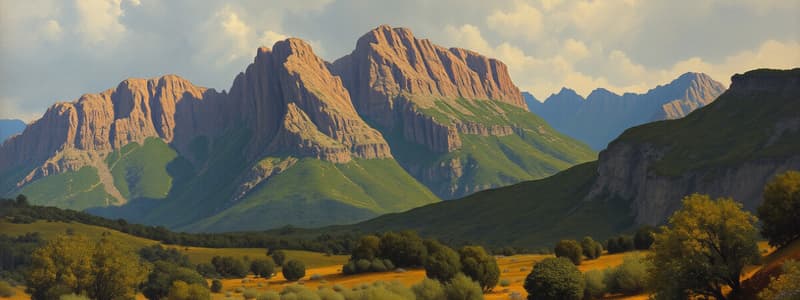Podcast
Questions and Answers
Which region of Texas is known for its deserts and mountains?
Which region of Texas is known for its deserts and mountains?
- Great Plains
- Coastal Plains
- Central Plains
- Mountains & Basins (correct)
What major city is located in the Central Plains region?
What major city is located in the Central Plains region?
- Fort Worth (correct)
- El Paso
- Houston
- San Antonio
Which of the following resources is NOT commonly found in the Coastal Plains?
Which of the following resources is NOT commonly found in the Coastal Plains?
- Copper (correct)
- Natural gas
- Cotton
- Oil
What natural feature is famous in the Great Plains region of Texas?
What natural feature is famous in the Great Plains region of Texas?
Which lifestyle activity is predominantly associated with the Central Plains?
Which lifestyle activity is predominantly associated with the Central Plains?
What feature is a characteristic of the Mountains & Basins region in Texas?
What feature is a characteristic of the Mountains & Basins region in Texas?
Which region is notable for extreme temperature variations and major agricultural output?
Which region is notable for extreme temperature variations and major agricultural output?
Which of the following cities is located in the Central Plains region?
Which of the following cities is located in the Central Plains region?
What is a defining characteristic of the Coastal Plains region?
What is a defining characteristic of the Coastal Plains region?
What type of climate does the Central Plains region experience?
What type of climate does the Central Plains region experience?
Flashcards are hidden until you start studying
Study Notes
Mountains & Basins
- Located in West Texas, characterized by deserts and mountains.
- Features rocky canyons and an arid climate, hot, dry, and windy.
- Rich in resources such as oil, natural gas, limestone, copper, clay, salt, sulfur, talc, and shale.
- Notable for Big Bend National Park and El Paso, the largest Texan city with a population exceeding 500,000.
Great Plains
- Situated in central and western Texas, extending from the Caprock Escarpment to the Texas Hill Country.
- Features high, flat grasslands with extremely hot summers and freezing winters, along with occasional tornadoes.
- Major agricultural producer of wheat, cotton, and sorghum; significant cattle ranching area.
- Home to Llanite, a rare pink granite, and the Palo Duro Canyon, the second largest canyon in the U.S.
Central Plains
- Located in central Texas, marked by rolling hills and grassy lands, bridging wetter and drier regions.
- Agrarian lifestyle includes farming for cotton, corn, and grains, as well as livestock raising for beef, sheep, hogs, and chickens.
- Natural resources include oil, gas, limestone, sand, and gravel.
- Major city is Fort Worth, known for agriculture, museums, and its meatpacking industry.
- Famous for Dinosaur Valley State Park, which preserves dinosaur footprints.
Coastal Plains
- Found in eastern Texas, adjacent to the Gulf of Mexico, with low-lying marshes and areas near sea level.
- Agricultural focus on farming cotton, corn, and sorghum, complemented by fishing owing to proximity to the Gulf.
- Oil extraction is a significant resource in several sub-regions.
- Notable cities include Houston, the largest city in Texas, and San Antonio, which hosts the historic landmark The Alamo.
Mountains & Basins
- Texas's least populated area characterized by rugged terrain, tall peaks, rocky canyons, and a hot, dry climate.
- Supports livestock and limited agriculture despite challenging environmental conditions.
- Rich in natural resources, particularly oil, gas, and minerals.
- El Paso is the largest city and a significant tourist draw, featuring attractions like Big Bend National Park and the McDonald Observatory.
Great Plains
- High, flat grassland region with extreme temperature variations, enhancing its unique ecosystem.
- Comprises the High Plains, Edwards Plateau, and Llano Basin, known for major agricultural production.
- Natural resources include oil and mohair, contributing to the economy.
- Home to Palo Duro Canyon, the second largest canyon in the United States.
Central Plains
- Features flat grasslands and rolling hills, prone to occasional tornadoes due to its climate.
- Divided into Grand Prairie, Cross Timbers, and Rolling Plains, excelling in agriculture and oil production.
- Key cities include Fort Worth, a hub for commerce and culture.
- Attractions like Dinosaur Valley State Park highlight the region's natural beauty and history.
Coastal Plains
- The largest region in Texas with a humid climate and diverse sub-regions such as Piney Woods, Gulf Coast Plain, South Texas Plain, Post Oak Belt, and Blackland Prairie.
- Known for its fertile soil, supporting extensive agricultural activities.
- Significant oil production contributes substantially to the state's economy.
- Major cities like Houston and Dallas play pivotal roles in various industries, including agriculture, lumber, and oil.
Studying That Suits You
Use AI to generate personalized quizzes and flashcards to suit your learning preferences.




